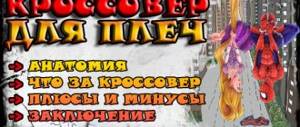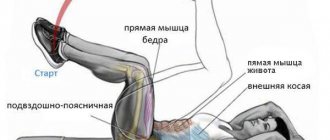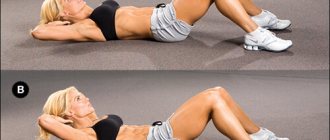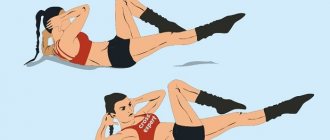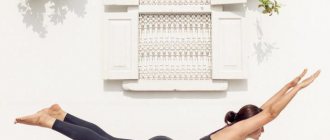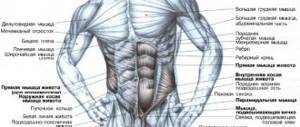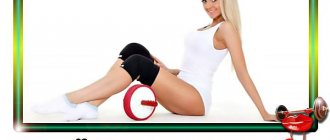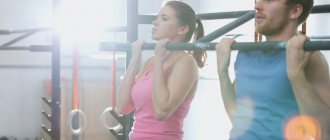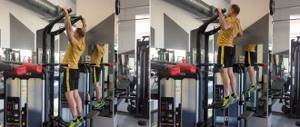“Prayer” crunches on the upper block on the press
The “prayer” exercise in a sports club is done using a special simulator. The exercise is a crunch of the upper part of the body on the upper block.
The exercise is quite widespread among professionals due to its high effectiveness.
The effectiveness of this exercise is achieved by using the maximum range of motion of the upper body.
But, the effect is achieved only with the correct execution technique, which also ensures the safety of movements.
But to perform the exercise, you don’t have to visit a sports club; it can be performed quite successfully without a special simulator.
Advantages
Unlike the classic version on an incline bench, crunches on the upper block can give you much more advantages:
- Working out the rectus abdominis muscles
- Like a plank, the exercise will strengthen your core muscles and improve your posture.
- Even distribution of load over the entire part of the press
- Gentle loads on the spine, which allows you to include exercise in the training program after injuries
- The ability to progress in weight, which will improve the development of the abdominal muscles
- Crunches can be performed in different positions, focusing on different parts of the abs
- Reducing your waist to create a classic V-shape.
“Prayer” Technique of execution without a simulator
Outside the gym, an expander band can be used to perform the “Prayer” exercise. Can also be performed with a light dumbbell.
Currently, the choice of expander bands, in terms of quality and potential load created, is huge.
Everyone can choose the level of starting load for themselves, and regularly progress, increasing it. At the same time, achieving more impressive results and health.
But initially, do not rush to use a lot of resistance. Start with minimal load! Feel the target muscle, turn on the mental-muscular connection and practice the technique.
The technique of performing the “Prayer” exercise must be strictly followed, otherwise non-target muscles will be involved. There may also be unwanted stress on the lumbar spine.
Kneel from the band at a distance slightly larger than your body. Grasp the tape with both hands (you can use gloves). At the same time, there are several options for holding hands:
- close grip, hands under the throat;
- middle hand in the forehead area;
- and distant, arms above your head.
Which option to choose depends on the individual structure of the upper body and shoulders.
There are also three options: direct grip of the tape, direct, reverse, neutral. You need to experiment! You can do it in different approaches, use different grips, you can do it through training, you can do it for a month with one, then change. Choose the most effective one for you. I tend to use a medium neutral grip.
If you use a close and medium grip, do not transfer even part of the load to the neck muscles, resting your forehead on the band. In this design, you will receive unwanted stress on the upper spine. If your muscles are not ready to bear this amount of load, this can lead to injury. The entire load must be transferred to the body through stable arms and shoulders !
The main thing is that while performing twisting, your hands should be motionless. All the work is done by the abdominal muscles, primarily the rectus muscle .
Otherwise, the main load will be borne by the shoulder muscles and the latissimus dorsi muscle.
I must say that in this case the shoulders and back are also well worked out, but this will be a different exercise, with different goals.
We perform twisting while exhaling. Slowly, including the mental-muscular connection aimed at the rectus abdominis muscle , or rather at its upper part. At the same time, the lower back, the lower back, remains practically motionless and does not bear a direct load.
Most importantly, the upper part of the body must be twisted so that the forehead is directly against the floor. Thus, you should round your back. Stay in this position for a few seconds.
Start inhaling and return slowly to the starting, upper position. Straightening up only by relaxing the rectus muscle.
With the correct technique, the “prayer” exercise is isolating.
Work on mistakes
Although many people call crunches on the upper block a children’s exercise, it has its own nuances.
- If you want to place more emphasis on the oblique muscles, install a single handle and perform torso twists with an upper block along a modified trajectory: the elbow should go towards the opposite thigh.
- Focus on the negative phase, returning slowly to the starting position from the bottom point. On the contrary, bending should be faster.
- Watch your hips: they should be in the same position throughout the entire exercise.
- Try to progress in weight if you want to increase the volume of your abdominal muscles and achieve a good definition of the cubes.
- Try not to help yourself with your hands: in this case, you will reduce the load on your abs.
block exerciser crunch crunch
How to increase the effectiveness of the Prayer exercise
There are several points that will significantly increase the effectiveness of this effective exercise.
- Firstly, complete control of the entire twisting process through the mental-muscular connection;
- Secondly, crunches can be performed in conjunction with the “vacuum belly” exercise;
- Thirdly, in between approaches, do “deep breathing”;
- Fourth, we perform the exercise slowly, with an emphasis on the negative phase. Those. We do the exercise on a count of 12, twisting - 1.2, fixation at the bottom point - 3,4,5, upward movement - 6, 7, 8, 9, fixation at the top point - 10, 11, 12;
- And fifthly, we do the “Prayer” exercise in isotonic mode. Those. at the top point we do not straighten up completely. The core muscles remain under load throughout the entire approach.
Exercise “Prayer” and pumping
Try to increase the effectiveness of the “Prayer” exercise with pumping. The pumping, of course, in this case will be insignificant, but nevertheless, I think everyone will feel the benefit from it.
To do this, try doing the “Prayer” exercise while standing. It is better to stand firmly with your back against a vertical surface. Place your hands on the border of the hairline. Reduce the amplitude, work in the middle part, that is, do not completely curl and do not completely straighten. The tape can be attached above the head.
Otherwise, follow the basic exercise technique completely. But with one exception, do the crunches quickly enough, but not at the expense of technique!
Watch your lumbar region!
Do two sets of 12-15 repetitions before the first basic set. You can repeat the pump, 1 set, after the third basic set before the fourth.
How to perform abdominal crunches with body rotations?
Crunches with body rotations are an excellent exercise for working the rectus and oblique abdominal muscles. In bodybuilding, there are a large number of options for performing this exercise, but the most common of them are crunches while lying on the floor or a Roman bench.
Technique for performing crunches with body rotations
Main muscles worked: rectus abdominis and obliques.
Technique:
- Take a lying position on the floor or a Roman bench: in the first case, bend your knees and place them completely on your feet, and in the second, fix your legs under the support bolsters;
- Place your hands on the back of your head and lower yourself to the bottom of the exercise (if you are performing this exercise on the floor, then lower yourself to the floor; if you are using a Roman bench, then position your body parallel to the floor or slightly lower);
- Begin to twist, rising upward due to the isolated effort of the abdominal muscles, while turning the body first to the left, then to the right, placing your left hand behind your right leg, and your right hand behind your left leg;
- Maintain a low pace of the exercise, take a short pause at the top point of the amplitude;
- Perform 3 sets of 15 reps each.
Practical recommendations
- Do not use the force of inertia, but try to perform the exercise using isolated abdominal pressure;
- Do not bend your neck too much, a slight rotation of the body will be enough;
- Do not help yourself with your hands and do not try to touch your elbows to your legs;
- When performing the exercise on a Roman bench, use a short range of motion - do not lie completely on the bench, but keep your body parallel to the floor;
- When doing Roman crunches, keep your back rounded throughout the entire set.
“Prayer” what muscles are involved
When performing the “Prayer” exercise correctly, the goal is “upper abs.” Twisting is performed by the rectus abdominis muscle, which is the target muscle. All concentration must be directed to the upper part of the rectus muscle.
Including, “Prayer”, with the correct technique, strengthens and develops the internal and external oblique muscles, the transverse abdominal muscle, as well as the serratus muscles.
During an eccentric movement, the back muscles that extend it are activated.
Basic mistakes during the exercise
One of the most basic problems with doing crunches is that beginners often confuse crunches with bending. The bottom line is that when bending over, completely different muscle groups are involved and the abdominal muscles are practically not involved, as a result - this exercise remains absolutely useless.
What other problems may not only beginners, but also professionals encounter:
- long pauses. It would seem like a mere trifle, but what happens in practice? Each repetition must follow the other without interruption, this becomes the key to the effectiveness of the exercises. But rest is necessary between approaches;
- straight back. You need to remember the difference: when performing an exercise with a straight back, the back muscles are worked, while doing crunches, the load falls on the abs;
- swinging the body to the sides. The torso must be kept in one position, otherwise part of the load is transferred to the hips;
- heavy weight As a result: strained arm muscles, injuries to the elbow joints and limited ability to perform the exercise correctly.
What will happen if you do this exercise regularly:
- Improves the condition of the superficial and deep abdominal muscles;
- Achieving six-pack abs and an ideal belly shape;
- Improved posture;
- Strengthening your back, which will reduce the likelihood of injury in the future;
- Increased abdominal muscle strength.
Crunching on a block is one of the most effective techniques that helps develop the abdominal muscles. An alternative to this exercise is the block crunch while lying on the floor. Crunching is an effective exercise, but not the only one you can equip yourself with, it all depends on both the level of training and the state of health and the ultimate goal.
Warm-up and cool-down
To warm up and activate the target muscles, be sure to do a warm-up. For warming up, exercises designed to warm up the shoulders and core muscles are suitable. You can use various sports equipment for this. In this case, a good exercise for warming up the muscles is performed using TRX loops.
For warming up, you can also use an expander band to work out and warm up the muscles of the upper body.
Without sports equipment, to warm up, do 1-2 sets of bending forward and backward. And 1-2 sets of push-ups, 8-10 repetitions for each exercise.
The cool-down should be aimed at stretching the abdominal muscles and activating the antagonist muscles.
Full body exercise
To strengthen and stretch the muscles of the lower part of the body, as well as to prevent lower back pain
You can do the “Wind Rose” exercises from the author.
It is very advisable, after performing the prayer, to do 1-2 exercises on the back muscles. Pay special attention to the erector spinae muscle.
After this, perform the “Breathing Pullover” exercise, designed to stretch the chest muscles.
Also, to restore blood supply to the thoracic region and breathing, it will be useful to perform the “whole body breathing” exercise.
Strengthening the effect of the “Prayer” exercise with other exercises.
To comprehensively work out your core muscles, you can use several more effective exercises for home during your workout. Including an excellent exercise for the lower abs and working on the Apollo-Adonis belt
and a plyometric pocket knife.
Contraindications for the exercise “Prayer”
As with any other effective exercise, there are several contraindications to the “Prayer” exercise. For those who have heart disease, lung disease, gastrointestinal tract, or hypertension, it is better not to perform this exercise. Also, you should not include this exercise in your training plan if you have spinal diseases.
To avoid negative effects on the body, be sure to follow the correct technique for performing the exercise, especially on the last repetitions and approaches. If it is difficult to complete the last repetitions correctly, reduce their number or reduce the load. It is very important!
Good luck!
If you liked the article and think that this information can be useful to friends and acquaintances, you can use any messenger to transmit it, the icons of which are located below, at the end of the article. Sincerely, Smart Fitness Path of Freedom!

